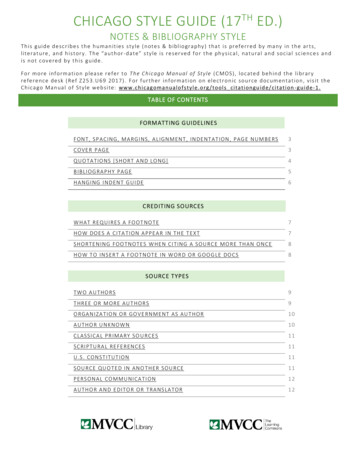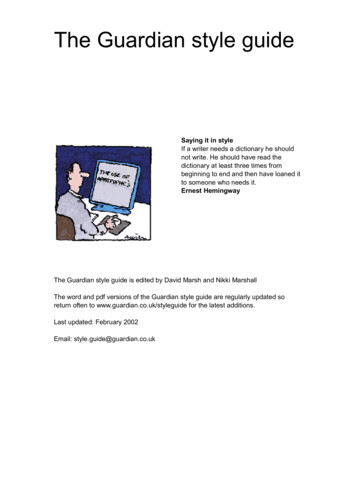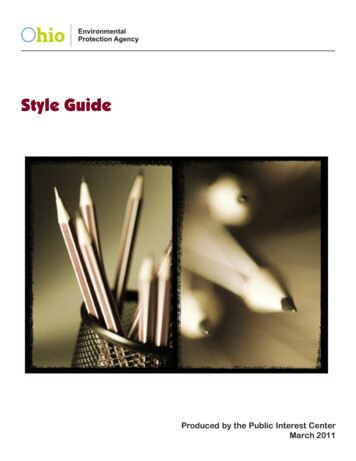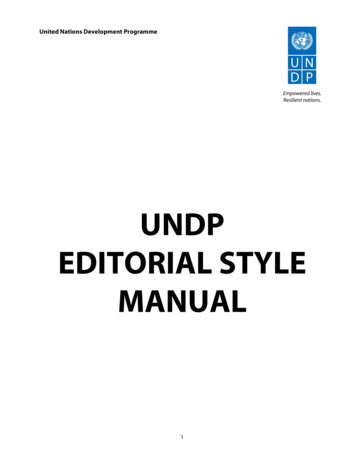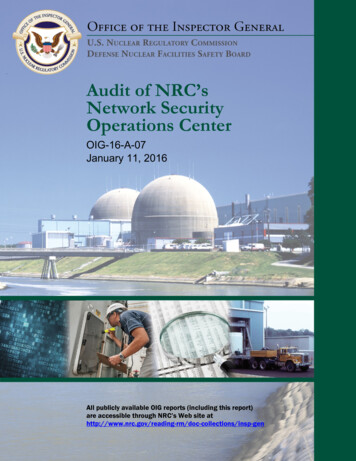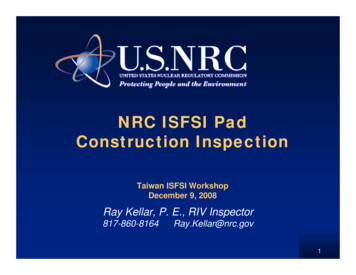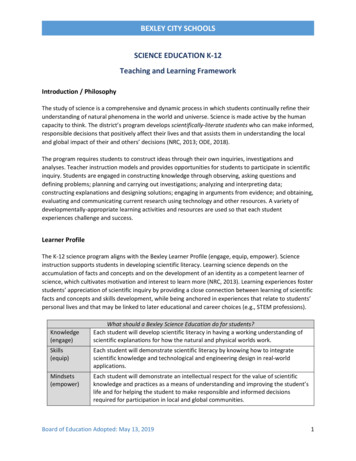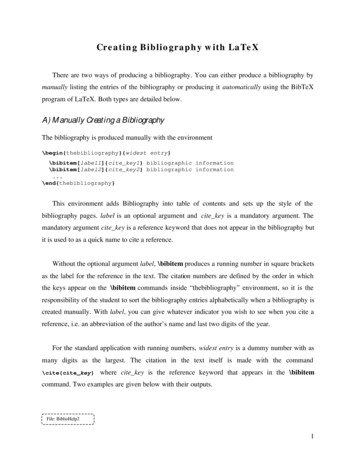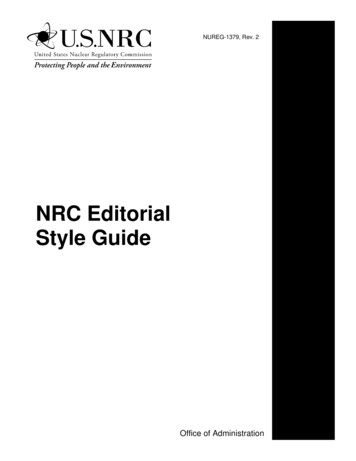
Transcription
NUREG-1379, Rev. 2NRC EditorialStyle GuideOffice of Administration
AVAILABILITY OF REFERENCE MATERIALSIN NRC PUBLICATIONSNRC Reference MaterialNon-NRC Reference MaterialAs of November 1999, you may electronically accessNUREG-series publications and other NRC records atNRC’s Public Electronic Reading Room athttp://www.nrc.gov/reading-rm.html.Publicly released records include, to name a few,NUREG-series publications; Federal Register notices;applicant, licensee, and vendor documents andcorrespondence; NRC correspondence and internalmemoranda; bulletins and information notices;inspection and investigative reports; licensee eventreports; and Commission papers and their attachments.Documents available from public and special technicallibraries include all open literature items, such asbooks, journal articles, and transactions, FederalRegister notices, Federal and State legislation, andcongressional reports. Such documents as theses,dissertations, foreign reports and translations, andnon-NRC conference proceedings may be purchasedfrom their sponsoring organization.NRC publications in the NUREG series, NRCregulations, and Title 10, Energy, in the Code ofFederal Regulations may also be purchased from oneof these two sources.1. The Superintendent of DocumentsU.S. Government Printing OfficeMail Stop SSOPWashington, DC 20402–0001Internet: bookstore.gpo.govTelephone: 202-512-1800Fax: 202-512-22502. The National Technical Information ServiceSpringfield, VA 22161–0002www.ntis.gov1–800–553–6847 or, locally, 703–605–6000A single copy of each NRC draft report for comment isavailable free, to the extent of supply, upon writtenrequest as follows:Address: U.S. Nuclear Regulatory CommissionOffice of AdministrationMail, Distribution and Messenger TeamWashington, DC 20555-0001E-mail:DISTRIBUTION@nrc.govFacsimile: 301–415–2289Some publications in the NUREG series that areposted at NRC’s Web site ns/nuregsare updated periodically and may differ from the lastprinted version. Although references to material foundon a Web site bear the date the material was accessed,the material available on the date cited maysubsequently be removed from the site.Copies of industry codes and standards used in asubstantive manner in the NRC regulatory process aremaintained at—The NRC Technical LibraryTwo White Flint North11545 Rockville PikeRockville, MD 20852–2738These standards are available in the library forreference use by the public. Codes and standards areusually copyrighted and may be purchased from theoriginating organization or, if they are AmericanNational Standards, from—American National Standards Institute11 West 42nd StreetNew York, NY 10036–8002www.ansi.org212–642–4900Legally binding regulatory requirements are statedonly in laws; NRC regulations; licenses, includingtechnical specifications; or orders, not inNUREG-series publications. The views expressedin contractor-prepared publications in this series arenot necessarily those of the NRC.The NUREG series comprises (1) technical andadministrative reports and books prepared by thestaff (NUREG–XXXX) or agency contractors(NUREG/CR–XXXX), (2) proceedings ofconferences (NUREG/CP–XXXX), (3) reportsresulting from international agreements(NUREG/IA–XXXX), (4) brochures(NUREG/BR–XXXX), and (5) compilations of legaldecisions and orders of the Commission and Atomicand Safety Licensing Boards and of Directors’decisions under Section 2.206 of NRC’s regulations(NUREG–0750).
NUREG-1379, Rev. 2NRC EditorialStyle GuideManuscript Completed: May 2009Date Published: May 2009Prepared byC. HsuOffice of Administration
AbstractThe “NRC Editorial Style Guide” provides writing and style guidance to all U.S. NuclearRegulatory Commission (NRC) staff members. It addresses the questions and issuesmost frequently fielded by NRC editors. This revision of the document emphasizes theimportance of plain language and includes detailed guidance on using technology towrite and edit more effectively. The goals of the “NRC Editorial Style Guide” arereadability and consistency for all NRC publications.iii
ContentsAbstract.iiiContents. vPreface.viiAcknowledgment. ix1Abbreviations and Symbols. 12Acronyms and Initialisms . 33Capitalization. 54Compound Terms and Unit Modifiers . 95Numbers. 136Punctuation . 197Plain Language . 278Word Usage . 339Footnotes and Credit Lines . 3710References. 3911Federal Register Documents . 4312Technology and Writing . 4713Writing in New Media . 4914Helpful Web Reference Tools . 51Appendix Sample NUREG. 53Bibliography . 65Index. 67v
PrefaceEditorial style refers to the choices that writers and editors make to eliminateinconsistencies in their documents. These choices are sometimes difficult becauselanguage evolves. In updating this style guide, words related to new technologies poseda special challenge. Is it Email, E-mail, e-mail, or email? The U.S. Government PrintingOffice standard is e-mail, but this guidance clashes with a trend towards closinghyphenated words. The example shows that the authorities who compile style guides donot always agree. Moreover, each discipline has specific standards.The Office of Administration compiled the revised “NRC Editorial Style Guide” topromote the goals of readability and consistency for all NRC publications. To addressfrequent staff questions, we have introduced several new sections. Technology andWriting covers key word processing tools for writing, editing, and clearing hidden datafrom final documents. We have also provided a Helpful Web Reference Tools section topoint writers towards resources like a glossary, a list of abbreviations, and NRC Webpages with document templates and more specific guidance. The URLs provided werefunctional at the time of printing. For the most part, this style guide derives its solutionsfrom the U.S. Government Printing Office Style Manual, with a few exceptions that wehave noted. We also turned to The Chicago Manual of Style, and the MLA Handbook forWriters of Research Papers for guidance.Follow this style guide for most documents, but remember that the NRC is aninterdisciplinary agency producing everything from legal rulings to public serviceannouncements. The Office of the General Counsel has its own style guide. NRC pressreleases are written for the media, and most media outlets follow The Associated PressStylebook. In addition, conferences and scholarly journals often have their own in-housestyles that NRC staff members must follow.As an author, identify your intended audience and determine if that audience has aseparate style standard. Most importantly, strive to communicate clearly andcomprehensibly with your audience. Even if you are writing for a technical audience, theNRC serves the public and the public has a right to read and understand the agency’sdocuments. Please see tips in the new Plain Language section in this guide to makeyour writing more clear, direct, and powerful.For user convenience, we have tried to make this guide a compact, easy-to-usereference. Of course, a guide of this size cannot substitute for the scope of informationin the GPO Style Manual, which sets the style rules for the Federal Government. Pleaserefer to the GPO Style Manual for style information not covered by this guide.vii
AcknowledgmentWe wish to acknowledge the contributions of the NRC staff members who participatedin Revision 2 of NUREG–1379, “NRC Editorial Style Guide.” Michael Lesar’s leadershipand management skills made this style guide possible. Malcolm Patterson gavevaluable input on the needs of the agency’s technical staff. Georgette Price andCatherine Jaegers from the Office of the Executive Director for Operations providedtheir valuable time and institutional knowledge of traditional NRC practices. Gary Laufferprovided oversight as well as knowledge of U.S. Government Printing Office practices.Keith Azariah-Kribbs contributed with knowledge of major style guides and years oftechnical editing experience. Cindy Bladey answered difficult style questions.Linda Stevenson provided a rigorous manuscript review. We also acknowledge theNUREG-1379, Revision 1, working group members, listed below. Finally, we thank stafffrom the Office of Administration who published the “NRC Editorial Style Guide” inOctober 1989: J.F. Beeson, B.A. Calure, D. Gable, M.T. Lesar, M.F. Mejac, andR.F. Sanders.NUREG-1379, Revision 1Working GroupADMCaroline HsuADMHelen ChangEDOAnn ThomasEDOMindy LandauFSMECatherine PolandFSMEPatricia TresslerHRJames MorrisNRRMalcolm PattersonOISPaula GarrityOPAIvonne CouretSECYSam Walkerix
1Abbreviations and SymbolsUse abbreviations and symbols in technical text, reports, tables, brackets, footnotes,and references. Generally, avoid abbreviations and symbols in the conventional text(e.g., correspondence). Consult NUREG–0544, “NRC Collection of Abbreviations,”available at gs/staff/sr0544/r4/ in theNRC Electronic Reading Room.Chapters 9 and 10 of the GPO Style Manual (http://www.gpoaccess.gov/stylemanual)present a comprehensive list of abbreviations, signs, and symbols and guidance fortheir use. Follow the guidance in these chapters and the rest of this section unlesspublication requirements for a particular document dictate otherwise. For example, topublish an article in a journal, you may need to follow the publisher’s in-house style. TheNRC uses the metric system. If in certain cases you must use nonmetric units, pleasestate the values in metric units first, followed by nonmetric units in parentheses.1. Use the same form of an abbreviation for both the singular and plural forms of a unit ofmeasure. 1m3m1 kg5 kg2. Omit internal and terminal punctuation unless its omission would cause confusion. 1 in. (Period avoids confusion with the word “in”.)5 cm3. Use abbreviations for units of measure only if they are used with numbers. 200 r/min (but—The test would determine the number of revolutions per minute.)4. State the term from which an abbreviation not commonly known is formed, followed by itsabbreviation in parentheses. Subsequently, use the abbreviation instead of the term.Redefine abbreviations in every new chapter or major section. iodine–131 metaiodobenzylquanidine (I–131 MIBG)60 indicated horsepower (ihp)electromotive force (emf or EMF)1
5. Use periods in abbreviations for foreign phrases. (Et is Latin for “and”; therefore, it is not anabbreviation.) et al. (for et alii, meaning “and others”)e.g. (exempli gratia, meaning “for example”)i.e. (id est, meaning “that is”)et seq. (for et sequentes, meaning “and the following”)6. The abbreviations e.g. and i.e. (followed by a comma) should be used only insideparentheses; otherwise, write out the English equivalents. Do not italicize e.g. and i.e. Today we received specific instructions for preparing the report (i.e., its due date,contents, and format).Today we received specific instructions for preparing the report, that is, its due date,contents, and format.7. Use the U.S. Postal Service two-letter State and Province abbreviations in any address orcapitalized geographic term. Prince George’s County, MD Atlanta, GA but—deciduous forests of Wisconsin; black sand beaches in Hawaii2
2Acronyms and InitialismsAlthough acronyms and initialisms are types of abbreviations, the guidance for their usediffers from that for other types of abbreviations. An acronym is a pronounceable termformed from the initial letters of a compound expression (e.g., LOCA for loss-of-coolantaccident). An initialism is a nonpronounceable term formed from the initial letters of acompound expression; the initial letters are pronounced as separate letters (e.g., NRCfor the U.S. Nuclear Regulatory Commission).Most acronyms are capitalized except for certain well-known acronyms that are lowercase by convention. For a list of commonly used NRC acronyms, see NUREG–0544,“NRC Collection of Abbreviations,” at s/staff/sr0544/r4/ in the NRC Electronic Reading Room.1. Use an acronym or initialism if the term it represents will be used more than severaltimes in a document. The first time a term is used, state the words from which the acronymis formed, followed by the acronym in parentheses. As a general rule, you can subsequentlyuse the acronym instead of the term. In a lengthy document, restate the term followed byits acronym at the beginning of each chapter or major section. However, keep in mindthat excess acronyms and abbreviations can make an otherwise well-writtendocument difficult to understand. When writing for a lay audience, or even a technicalaudience that does not share your specialty, use acronyms carefully. You may sometimesneed to redefine an acronym, offer a brief explanation of the acronym, or use a synonyminstead. Always avoid stringing several acronyms together in a single sentence. Do notinclude acronyms in headings and titles. The Resource Advisory Council (RAC) has reviewed this plan. The RAC advised thestaff to revise three sections.The Resource Advisory Council has reviewed this plan. The council advised the staff torevise three sections.2. Although an acronym or initialism is capitalized, do not capitalize the term it representsunless the term would ordinarily be capitalized. Office of the General Counsel (OGC)technical specification (TS)crack opening displacement (COD)3. To form the plural for most acronyms and initialisms, add a lower case s without anapostrophe. 12 NPPsfive RGs2.0 FTEs3
4. To form the possessive of an acronym or initialism, use an apostrophe plus s, just as youwould for a normal word. EDO’s reportIAEA’s May conferenceRES’s funding (also—funding from RES; RES funding)O3’s chemical instability (also—ozone’s chemical instability; the chemical instability ofO3)5. To decide whether a or an should precede an acronym or initialism, pronounce the firstsyllable of the acronym. “A” should precede a consonant sound; “an” should precede avowel sound. an ACRS meeting (“ay” is a vowel sound)an AEC report (“ay” is a vowel sound)a FEMA decision (“fee” is a consonant sound)an NRC office (“en” is a vowel sound)a LOCA occurred (“low” is a consonant sound)4
3CapitalizationCapitalize the first word of a sentence, the pronoun I, and proper names. When indoubt, do not capitalize. For example, if a term could be either a proper name or adescription (e.g., the department of engineering or nuclear power plant), using the lowercase is correct.1. Capitalize titles of persons if they precede a personal name. Use lowercase if the titlefollows the name except for titles of great eminence, including heads of state, assistantheads of state, heads of governmental units, and royal rulers. Do not capitalize generalreferences to titles. Likewise, capitalize specific names of organizations but not generalreferences to them. President George Washington (and also—the President)King Bhumibol Adulyadej (and also—the King of Thailand; His Royal Highness)Governors Richardson and Lingle (and also—The Governors will meet later.)U.S. Senator Daniel Inouye (but—Daniel Inouye, senator; the senator)The staff in Region IV (but—the regional office)Judge Mia Jones (but—Mia Jones, the judge)For NRC titles, follow the above guidance, but you may capitalize titles of branch chief andabove. This NRC practice differs significantly from GPO Style Manual Rule 3.35. Do notcapitalize general references to most titles. NRC Senior Health Physicist Ana Lee (but—two NRC health physicists)Deputy Director Ryan Yamada (and also—Ryan Yamada, Deputy Director)NRC Director of Human Resources, David Calvo (and also—David Calvo, Director of theOffice of Human Resources)2. Capitalize Commission or Commissioners when referring to the collegial head of the NRCas a group and Chairman or Commissioner when referring to the Chairman or a memberof the Commission individually. This NRC practice differs from GPO Style Manual Rule 3.35. The Chairman requests a response by Friday and expects the Commission to discussthe issue Monday morning.5
3. Capitalize a well-known short form of a specific proper name. the Congress (U.S. Congress, but—congressional action, congressional staff)the President (of any country)the District (District of Columbia)the Capitol (in the District)the Agency (for U.S. Central Intelligence Agency, U.S. Environmental ProtectionAgency, but— the agency for U.S. Nuclear Regulatory Commission and all otherorganizations that do not have “Agency” in their official title)the Office (U.S. Government Accountability Office, but—the office for all other offices,including NRC internal offices)4. Capitalize the following governmental organizations. FederalFederal GovernmentState (but—do not capitalize “local”)Nation as a synonym for United States as in “10 percent of the Nation’s energy supply”(but—“nation” for general references such as “a nation devoted to prosperity”)Federal, State, and local respondersTribal officials (Unlike GPO, the NRC capitalizes “Tribal” to signify a sovereign entity.)5. Capitalize a common noun followed by a letter or number that refers to a specificpublication, class, figure, or table, except for page or paragraph. (This NRC practice differsfrom GPO Style Manual Rule 3.9.) Category IIAEA Category III sourcesAppendix KChapter IIIClass 1ETable 4Figure 8Section 7but—paragraph 4 on page 826. Capitalize the first letter of the symbol for an isotope, chemical element, or compound. Donot capitalize the spelled-out name for the symbol. NaNaClCo–60sodiumsodium chloridecobalt–606
7. Capitalize a trade name. XeroxHalogenPlexiglasVu–GraphZircaloy (but—zirconium)8. Capitalize the names of all computer codes, and capitalize the names of computerlanguages and software consistent with their trade names. If the code is an acronym, spellout the full name the first time it appears in a document. Code: MESORAD, CPLUMELanguage: Fortran, OracleSoftware: dBase, Lotus 1-2-39. Capitalize a descriptive term that denotes a geographic region or feature used as a propername. the Midwestthe Continental Dividethe Deep SouthWestern EuropeGulf States (but—gulf coast)10. Do not capitalize a term used as a geographic direction or a position that is not a propername. northerly, northernnorth, south, east, westeastern seaboardwest coast, east coast11. Capitalize months, but not seasons. May, Octoberspring, autumnspring 2007 (not—Spring 2007)12. Capitalize the first word and all important words in titles of publications and legislation. Secrets of the Past: Nuclear Energy Applications in ArtThe Paperwork Reduction Act of 19827
13. Do not capitalize articles, prepositions (except for “To” as part of an infinitive), andconjunctions unless they are the first word of a title or important to its meaning. How To Write, Speak, and Think More EffectivelyCreating Energy Sources for the FutureA Guidebook to Nuclear Reactors“Handbook of Nuclear Safeguards Measurements Methods”14. Capitalize hyphenated words by the same rules you would use if the words were nothyphenated. ex-President ClintonCommissioner-elect Joneshigh-level waste“A Study of Proposed High-Level Waste Repositories”15. Do not capitalize the names of systems at nuclear facilities. residual heat removal systememergency core cooling system16. Do not capitalize document types, unless followed by a number or letter referring to aspecific document. regulatory guide (but—Regulatory Guide 1.18)management directive (but—Management Directive 4.1, “Accounting Policies andPractices”)17. Do not capitalize a common noun followed by a letter or number identifying a componentof a nuclear power plant. train Avalve PRV–2218. Capitalize basic alphabet keys, all the named keys (e.g., Ctrl, Shift, Alt) and menu items(e.g., File, Save, Print). To run a spell check, go to Tools, then choose Spelling and Grammar.A keyboard shortcut for copying text is Ctrl C.19. Capitalize these technology-related words. For information on how to compoundtechnology-related words, see Section 4. InternetWeb pageWeb siteWeb8
4Compound Terms and Unit ModifiersA compound term can appear in one of the three following forms: (1) open (e.g.,nuclear power plant, mill tailings site), (2) closed (e.g., rulemaking, runoff), and(3) hyphenated (e.g., full-scale simulation, fitness-for-duty program). Although there arerules to compounding terms, there are also many exceptions. Modern English is movingtowards a general trend of closing compounds, unless doing so causes confusion. Forexample, the modifier on-line or on line, is now online.Chapter 6 of the GPO Style Manual presents general rules for compounding words. Tolook up a specific word, go to Chapter 7 of the GPO Style Manual, “CompoundingExamples,” where you will find 6,000 compound words in their correct open, closed, orhyphenated form. To find the GPO Style Manual online, go tohttp://www.gpoaccess.gov/stylemanual.Compound terms that modify nouns are called unit modifiers. Those that precedenouns are typically hyphenated. Those that follow the nouns they modify are typicallynot hyphenated. an NRC-sponsored study (but—a study sponsored by the NRC)an industry-sponsored study (but—a study sponsored by industry)handled on a case-by-case basis (but—handled case by case)Use hyphens carefully with unit modifiers because their placement can causemisreadings. For example, depending on the usage of the words, each of the followingphrases or sentences is correct. a biological-waste management systema biological waste-management systemThe following table provides detailed guidance on the use of hyphens with unitmodifiers.1. Hyphenate unit modifiers used as adjectives and adverbs that precede a noun. Sometypes and examples follow:TypeExampleModifier plus present participlefar-reaching effectshard-working stafffear-producing accidentthought-provoking analysis9
TypeExampleModifier plus past participlesafety-related activitiescoal-fired plantsperformance-based incentiveswell-defined planmuch-acclaimed studylong-lived isotopeMultiple-word modifiernot-in-my-backyard attitudeeasy-to-read documentloss-of-coolant accidentboiling-water reactorpressurized-water reactornozzle-to-pipe weldSuspended modifier (i.e., use of a unitcommon to a series of unit modifiers)industry- and agency-sponsored studieslong- and short-term goals8-, 9-, and 10-hour daysUnit modifiers in which one unit iscapitalizedPDR-available documentsNRC-prepared reportUnit modifiers that include numbers (seealso Section 5)18-inch-diameter pipesix-person teamtwo-shift operationA prefix before a proper noun, capitalizedabbreviation, or numbernon-Federalanti-Americanpre-Jurassicpre-NRC regulatory agencypost-2001 security measuresA few adjective-noun unit modifiershigh-level wastelow-pressure injectionlight-water reactornonlight-water reactornonsafety-related component2. Do not hyphenate (leave open) unit modifiers ending in ly, as well as certain other modifiers.Some types and examples follow:TypeExampleModifier ending in lypoorly managed planteffectively managed branchUnit modifiers both elements of which arecapitalizedan Appendix A criterion10 CFR Part 50 requirements10
TypeExampleForeign phrases used as unit modifiersad hoc meetingad hominem argumentin vitro tissue culturein situ hybridizationThree-word unit modifiers whose first twowords are adverbsvery well defined proceduresunusually well maintained design basisNoun formed from a one-syllable verb up3. Close up most prefixes, but be aware of many exceptions. Use a hyphen to avoidmispronunciation or confusion. Some types and examples follow:TypePrefixesUse a hyphen before a proper noun, capitalizedabbreviation, or number.Use a hyphen with prefixes to avoid doubling avowel or tripling a consonant, except after co,de, pre, and re. Also use a hyphen to avoidmispronunciation or lumbian artifactspre-2001 security wnerdeenergizere-creation vs. recreationmulti-ply vs. multiplypre-position vs. prepositionco-opun-ionized vs. unionized
4. Close most cases of wide and making used as a suffix. agencywide (but—NRC-wide because it is a proper policymakingGovernmentwide5. Usually, do not hyphenate chemical and physical terms except for chemical formulas. boric acid solutioncarbon monoxide gasequivalent uranium contenthydrogen ion activityground waterCr-Ni-Mo6. Follow these conventions for technology-related words. Be aware that conventions maychange. For guidance on capitalizing technology-related words, see Section 3 of this guide,“Capitalization.” Web pageWeb siteWeb-related issues (adjective form is still hyphenated)Web broadcastingWebcastinge-mailonlinedatabase12
5Numbers1. Spell out the numbers one through nine. Four reactor licensees reported seven events.The crew replaced four pipes, six valves, and nine gears in record time.not—The crew replaced four (4) pipes, six (6) valves, and nine (9) gears in record time.2. Use numerals for a single number of 10 or more. During August 1985, 21 plants submitted the required reports, but of these reports, twowere late.About 30 engineers attended the meeting.3. Spell out a number that begins a sentence, and spell out related numbers at the beginningof a sentence separated by no more than three words. Alternatively, revise the sentence toavoid beginning the sentence with a number. In these next examples, assume that theauthor has already defined Title 10 of the Code of Federal Regulations (10 CFR) Part 20,“Standards for Protection against Radiation.” As required by 10 CFR Part 20, radiation protection plans for certain facilities. (but—donot begin a sentence with “10 CFR Part 20 requires ”)Twenty families face possible evacuation.Seventy or, perhaps, eighty square miles were affected by the aftershock. or —Theaftershock affected approximately 70 or 80 square miles. (but—Eight acres of the 12square miles affected by the aftershock were within the site boundary.)4. When two or more related numbers appear in a sentence and one of them is 10 or more,use a numeral for each number. The inspectors found fractured pipes in four plants: 6 in Fermi, 10 in Watts Bar, 2 inMonticello, and 4 in Susquehanna.The NRC received comments from 13 utilities, 18 public interest groups, 3 unions,6 utility organizations, and 2 interested persons.5. Use numerals to express a unit of measurement, such as time or money. This usage doesnot affect other numerical expressions in a sentence. 2 meters15 years3.5 percent6-cm-diameter pipe13
Three NRC travelers left the office at 3:30 p.m. for a 4-day trip to join an eight-personadvisory committee on radiation safety. Each traveler had to travel approximately50 miles per day and each had a 600 travel advance. On this trip, a business daylasted about 10½ hours—beginning at 8 a.m. and ending about 6:30 p.m.—with a 1-hourbreak for lunch. Of the 8 members of the committee, 4 supervised a staff of 11 or morehealth physicists.6. In tables and illustrations, use numerals with abbreviations, symbols, decimals, andwith quantities that mix whole numbers and fractions. In text, do not use symbols. Writeout the abbreviation on first appearance in text and thereafter use the abbreviation.Tables and IllustrationsText3 km3 kilometers12 cm12 centimeters3′–6′ *3 feet to 6 feet12″ **12 inches8″ x 12″8 inches by 12 inc
New York, NY 10036–8002 www.ansi.org 212–642–4900 . Follow this style guide for most documents, but remember that the NRC is an . times in a document. The first time a term is used, state the words from which the acronym is formed, followed by the acronym in
